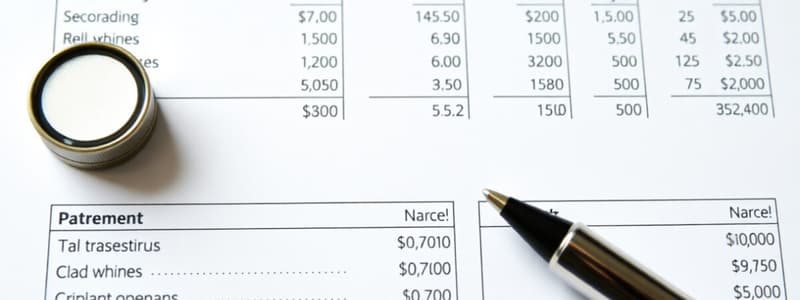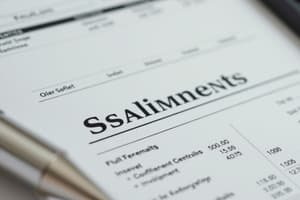Podcast
Questions and Answers
What is another name for the Statement of Financial Position?
What is another name for the Statement of Financial Position?
- Statement of Changes in Equity
- Statement of Cash Flows
- Balance Sheet (correct)
- Statement of Income
Which financial statement provides information on income and expenses?
Which financial statement provides information on income and expenses?
- Statement of Cash Flows
- Statement of Profit or Loss and other comprehensive income (correct)
- Statement of Changes in Equity
- Notes
What constitutes equity in a financial statement?
What constitutes equity in a financial statement?
- Total Income minus Total Expenses
- Liabilities minus Assets
- Assets plus Liabilities
- Assets minus Liabilities (correct)
How are assets classified as current?
How are assets classified as current?
Which financial statement provides narrative disclosures not presented in other statements?
Which financial statement provides narrative disclosures not presented in other statements?
What does 'realized' mean in a financial context?
What does 'realized' mean in a financial context?
Which of the following statements regarding trade receivables is correct?
Which of the following statements regarding trade receivables is correct?
How are liabilities classified as current?
How are liabilities classified as current?
What defines a trade payable?
What defines a trade payable?
What is typically assumed about an entity's normal operating cycle if it is not clearly identifiable?
What is typically assumed about an entity's normal operating cycle if it is not clearly identifiable?
Flashcards
Statement of Financial Position
Statement of Financial Position
A financial statement that shows a company's assets, liabilities, and equity at a specific point in time.
Current Assets
Current Assets
Assets expected to be converted into cash or used up within one year, or within the normal operating cycle, whichever is longer.
Statement of Profit or Loss
Statement of Profit or Loss
A financial statement that shows a company's revenues and expenses over a period of time.
Liabilities
Liabilities
Signup and view all the flashcards
Equity
Equity
Signup and view all the flashcards
Realized Inventory
Realized Inventory
Signup and view all the flashcards
Current Liabilities
Current Liabilities
Signup and view all the flashcards
Trade Receivables
Trade Receivables
Signup and view all the flashcards
Normal Operating Cycle
Normal Operating Cycle
Signup and view all the flashcards
Line Item (Balance Sheet)
Line Item (Balance Sheet)
Signup and view all the flashcards
Study Notes
Financial Statements
- Types of financial statements include the Statement of Financial Position (balance sheet), Statement of Profit or Loss and Other Comprehensive Income (income statement), Statement of Changes in Equity, Statement of Cash Flows, and Notes.
- The Statement of Financial Position shows the entity's assets, liabilities, and equity at a specific point in time.
- The Statement of Profit or Loss and Other Comprehensive Income reports income or loss over a period of time.
- The Statement of Changes in Equity shows the changes in equity accounts during a period.
- The Statement of Cash Flows details the cash inflows and outflows for a period.
- Notes provide additional narrative disclosures and other information required by accounting standards.
- Assets represent resources controlled by the entity, which are expected to provide future economic benefits.
- Liabilities represent present obligations of the entity to transfer economic resources as a result of past events.
- Equity represents the residual interest in the assets of the entity after deducting its liabilities.
Current and Noncurrent Items
- Current assets and liabilities are those expected to be realized or settled within one year or the operating cycle, whichever is longer.
- Noncurrent assets and liabilities are those expected to be realized or settled after one year or the operating cycle.
Presentation of Financial Statements
- Financial statements can be presented as classified (current/noncurrent) or unclassified.
- Classified statements categorize assets and liabilities based on liquidity (i.e., how easily they can be converted to cash).
- Unclassified statements group items without considering their liquidity.
Cash and Cash Equivalents
- Cash equivalents are highly liquid investments that can be readily converted to cash with insignificant risk of change in value.
Inventory
- Inventory is a current asset and is only for merchandising businesses.
Expenses
- Expenses are decreases in economic benefits during a period from outflows or consumption of assets or increases in liabilities, excluding those relating to investments by owners.
- Common expense categories can include costs of goods sold, distribution or selling costs, administrative or general and administrative costs, and other expenses.
Revenue and Gains
- Revenue is an inflow or enhancement of economic benefits during a period from ordinary activities of an entity. - Gains may or may not arise from the ordinary activities of an entity.
Income Statement vs. Statement of Comprehensive Income
- Income statements report only the profit or loss for a period.
- Statement of Comprehensive Income reports both the profit or loss and items that affect total comprehensive income, which may or may not be part of the ordinary activities of an entity.
Statement of Cash Flows
- The statement of cash flows provides information about the cash inflows and outflows of an entity during a period, categorized by operating, investing, and financing activities.
- Operating activities concern the principal revenue-producing activities of the business and other activities that are not included in investing or financing activities.
- Investing activities include the acquisition and disposal of long-term assets and other investments not included in the normal operating cycle.
- Financing activities concern the provision of capital to the entity and its repayment.
- The statement of cash flows can be presented using the direct or indirect method.
Additional Notes
- There are different business structures such as Sole Proprietorship, Partnership, Corporation, and Cooperative, each with unique legal and equity considerations.
Studying That Suits You
Use AI to generate personalized quizzes and flashcards to suit your learning preferences.




